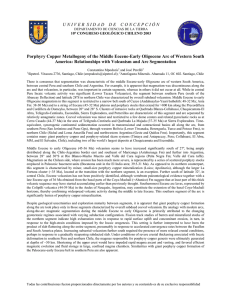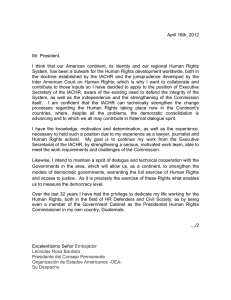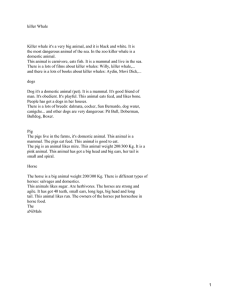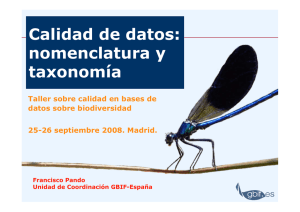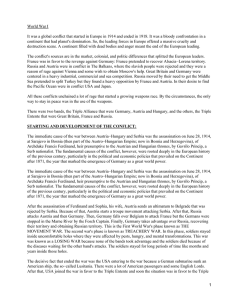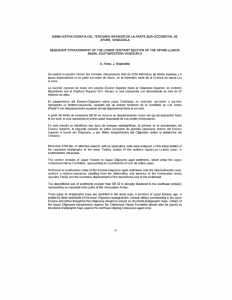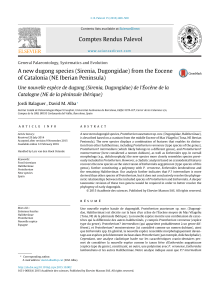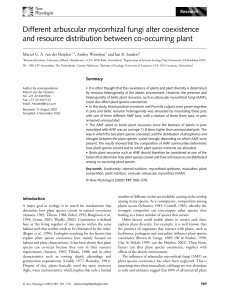Bulletin of the Geological Society of Denmark, Vol. 44/2, pp. 181-185
Anuncio
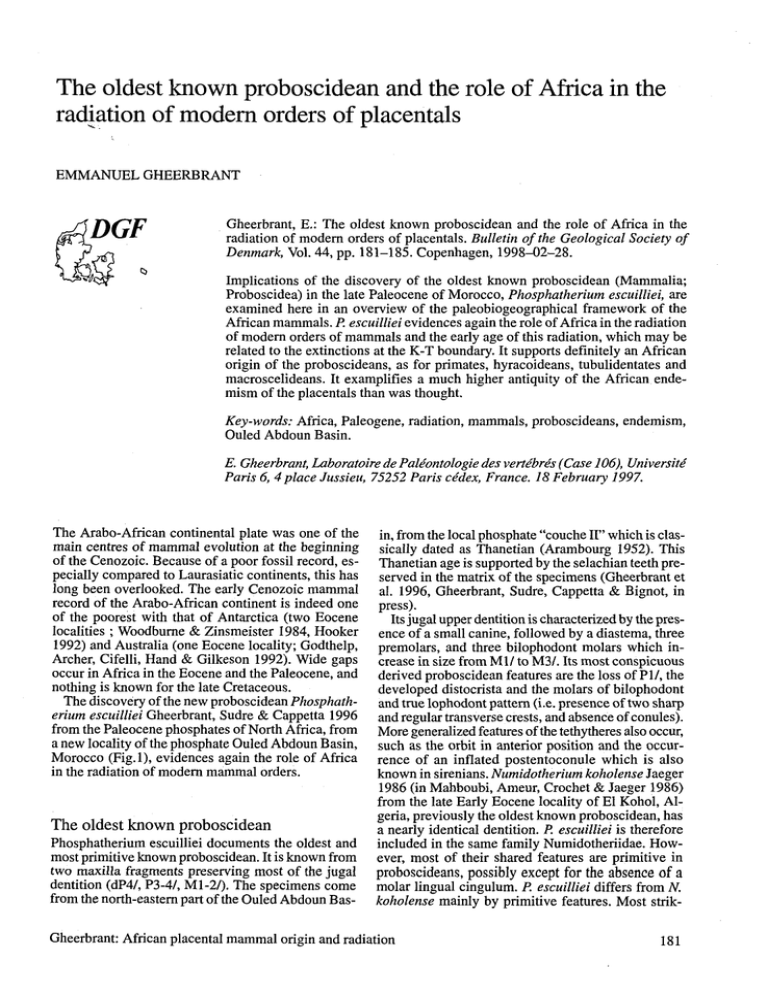
The oldest known proboscidean and the role of Africa in the = of modem orders of placentals radiation EMMANUEL GHEERBRANT Gheerbrant, E.: The oldest known proboscidean and the role of Africa in the radiation of modem orders of placentals. Bulletin of the Geological Society of Denmark, Vol. 44, pp. 181-185. Copenhagen, 1998-02-28. Implications of the discovery of the oldest known proboscidean (Mammalia; Proboscidea) in the late Paleocene of Morocco, Phosphatherium escuilliei, are examined here in an overview of the paleobiogeographical framework of the African mammals. P. escuilliei evidences again the role of Africa in the radiation of modern orders of mammals and the early age of this radiation, which may be related to the extinctions at the K-T boundary. It supports definitely an African origin of the proboscideans, as for primates, hyracoideans, tubulidentates and macroscelideans. It examplifies a much higher antiquity of the African endemism of the placentals than was thought. Key-words: Africa, Paleogene, radiation, mammals, proboscideans, endernism, Ouled Abdoun Basin. E. Gheerbrant,Luboratoire de Paldontologie des vertébrés (Case 106),Université Paris 6, 4 place Jussieu, 75252 Paris cédex, France. 18 February 1997. The Arabo-African continental plate was one of the main centres of mammal evolution at the beginning of the Cenozoic. Because of a poor fossil record, especially compared to Laurasiatic continents, this has long been overlooked. The early Cenozoic marnmal record of the Arabo-African continent is indeed one of the poorest with that of Antarctica (two Eocene localities ; Woodburne & Zinsmeister 1984, Hooker 1992) and Australia (one Eocene locality; Godthelp, Archer, Cifelli, Hand & Gilkeson 1992). Wide gaps occur in Africa in the Eocene and the Paleocene, and nothing is known for the late Cretaceous. The discovery of the new proboscidean Phosphatherium escuilliei Gheerbrant, Sudre & Cappetta 1996 from the Paleocene phosphates of North Africa, from a new locality of the phosphate Ouled Abdoun Basin, Morocco (Fig.l), evidences again the role of Africa in the radiation of modern mammal orders. The oldest known proboscidean Phosphatherium escuilliei documents the oldest and most primitive known proboscidean. It is known from two maxilla fragments preserving most of the jugal dentition (dP41, P3-41, Ml-21). The specimens come from the north-eastern part of the Ouled Abdoun Bas- in, from the local phosphate "couche II" which is classically dated as Thanetian (Arambourg 1952). This Thanetian age is supported by the selachian teeth preserved in the matrix of the specimens (Gheerbrant et al. 1996, Gheerbrant, Sudre, Cappetta & Bignot, in press). Its jugal upper dentition is characterizedby the presence of a smal1canine, followed by a diastema, three premolars, and three bilophodont molars which increase in size from M11 to M31. Its most conspicuous derived proboscidean features are the loss of Pll, the developed distocrista and the molars of bilophodont and true lophodont pattern (Le. presence of two sharp and regular transverse crests, and absence of conules). More generalized features of the tethytheres also occur, such as the orbit in anterior position and the occurrence of an inflated postentoconule which is also known in sirenians. Numidotherium koholense Jaeger 1986 (in Mahboubi, Ameur, Crochet & Jaeger 1986) from the late Early Eocene locality of El Kohol, Algeria, previously the oldest known proboscidean, has a nearly identical dentition. P. escuilliei is therefore included in the same family Numidotheriidae. However, most of their shared features are primitive in proboscideans, possibly except for the absence of a molar lingual cingulum. P. escuilliei differs from N. koholense mainly by primitive features. Most strik- Gheerbrant: African placenta1 mammal origin and radiation 181 Fig. 1. Location of the Ouled Abdoun Basin, Morocco (Fig. 1 in Noubhani & Cappetta, 1994). Phosphatherium escuilliei comes from the north-eastem part of the Ouled Abdoun Basin, from the "couche II" of the quarrier terminology which is dated as Thanetian on the basis of its fossil selachian fauna. ing is its much smaller size; based on allometric scaling of the teeth (Gingerich, Smith & Rosenberg 1982), its estimated body weight ranges from 10 to 15 kilograms, which corresponds to the smallest known proboscidean. Another striking primitive feature of f! escuilliei is the retention of a distinct centrocrista which is linked to an inflated mesostyle. This is a vestige of the dilambdodonty which is generalized in ungulates, known, e.g. in hyracoids, embrithopods, and perissodactyls. Paleobiogeographical framework and implications of the discovery of Phosphatherium escuilliei The discovery of a Paleocene proboscidean from the Arabo-African continent has several implications of broad interest for mammals. It ranks among the few known fossil occurrences of modem orders of mammals in pre-Eocene strata. Of the 18 extant placental orders, only 7 were previously recorded before the Eocene: the edentates (palaeanodonts), the lipotyphIans (especially nyctitheriids), the carnivorans (viverravids), the lagomorphs (mimotonids), the rodents (ischyromyids, eurymylids), the primates (Altiatlasius), and perhaps the dermopterans if plesiadapifonns really belong to this order. Actually, P. escuilliei is the oldest known modem ungulate, and the first one recorded from the Paleocene. According to current phylogenetic studies (e.g. Novacek 1992, 1993), 182 Proboscidea is among the most derived placental orders. The discovery of a Paleocene proboscidean is indeed the first direct evidence of the early age of the radiation of modem orders of placentals, which must be earlier than the late Paleocene. The radiation must also have been very rapid, with an "explosive" pattern, if it is closely correlative to the extinction events at the end of the Cretaceous. l? escuilliei emphasizes the ancient origin of the proboscideans of the Arabo-African continent and the antiquity of the placenta1 population on the continent. The early presence of placentals on the continent was already suggested by the diversified Thanetian Adrar Mgorn fauna from the Ouarzazate Basin, Morocco (Gheerbrant 1990), which is the only other known Paleocene mammal fauna from the Arabo-African continent. It was also suggested by the diversity and the strongly endemic character of later Paleogene African marnmal faunas. The endemism is still noticeable in extant African mammal faunas with the occurrence of peculiar taxa such as potamogales (tenrecids), golden moles (chrysochlorids), elephantshrews (macroscelideans),aardvarks (tubulidentates), hyraxes (hyracoideans), and the thryonomyid and anomalurid rodent families. However, it is during Paleogene time that the endemism of the mammals on the Arabo-African continent culminates. Among the known fossils, the then native mammals are strongly predominant. They belong to several lineages of extant taxa (Fig. 2): some, such as the primates and the proboscideans, are known as early as the late Paieocene; others, such as the macroscelideans, Bulletin of the Geological Society of Denmark Fig. 2. Temporal distribution of the mammal orders in the Arabo-African continent. For each order, the probable episodes of immigration in the Arabo-African continent are indicated by arrows (1). Discontinuous lines indicate uncertain fossil record. Paleogene localities: 1. Adrar Mgorn (Morocco), Ouled Abdoun (Morocco); 2. N'Tagourt 2 (Morocco); 3. El Kohol (Algeria), Chambi (Tunisia), Gour Lazib and Glib Zegdou (Algeria); 4. M'Bodione Dadere (Senegal), In Tafidet (Mali), Tamaguilelt (Mali), Kpogamé-Hahotoé (Togo); 5. Bir El Ater (Algeria), Dor El Talha (Evaporite Unit, Libya), Fayum (Qasr El Sagha Fm, Egypt); 6. Dor El Talha (Idam Unit, Libya), Fayum (Jebel Qatrani Fm, Egypt), Zella (Libya), Jebel Hasawnah (Libya), Taqah and Thaytiniti (Oman), Malembe (Angola), Jebel Bou Gobrine (Tunisia), Oued Bazina (Tunisia), Bled Mellaha (Tunisia). Paleocene Ma Eocene 65 Hyracoideans- - +€mbrithopods Perissodactyls ----- Miocene Pllo-Quat. Ollgocene 34 53 23.5 5.3 O --...... -------- - - .. - - - - - - - --- - - - -- - - - - - - - . - - - - - --- Arttodactyls '~reodonts - - - - -....g (hyaenodontids) Carnivores- - - - - q ? .w---- - . ? ---- Lipotyphlans ---- I Primates - - -- Macroscelideans- -.... - - - - - - ,,% ... .III.I.UIL.I m I - - - Paleogene l o c a l ~ t i e s O the first rhinolophoid and vespertilionoid chiropterans, the hyracoideans and the zegdoumyid rodents (considered as ancestral to the extant anomalurids by Vianey-Liaud et al. 1994), are known since the late early Eocene; and still others, such as the phiomyid rodents (presumed to be ancestral to extant thryonomyids), are known from the late Eocene. There are several other modem marnmal taxa which possibly or probably originated on the Arabo-African continent in Paleogene times (Fig. 3). Such is the case for the aardvark order (tubulidentates) and for the lipotyphlan families of golden moles (chrysochlorids) and potamogales (tenrecids), though none of them has a known fossil record before the Miocene. Sirenians are also sometimes considered of African origin; they beIong to the super-group Paenungulata, together with proboscideans and hyracoideans,both African. Moreover, the phiomorph rodents and the parapithecid pri- I O s . - . @ mates from the Paieogene of Africa me the most likely ancestorsof, respectively, the caviomorph rodents and the platyrrhine primates of South America. Finally, Gingerich (1986) has advanced the hypothesis of an African origin of flourishing Laurasiatic groups such as the adapiform and omomyiform primates, the hyaenodontid creodonts, the artiodactyls and the perissodactyls. Among them, artiodactyls and perissodactyls are major components of the extant herbivorous mammal fauna.The sudden appearance of these groups in Laurasiatic continents at the begimingof the Eocene suggests indeed their immigration from a poorly known south-Tethyan continent such as Africa. As a taphonomic bias, the Adrar Mgorn locality has not yielded large mammals such as ungulates. With l? escuilliei, the OuIed Abdoun Basin has produced the first representative of an order of large mammals from the Paleocene of the Arabo-African continent. It thus Gheerbrant: Afiican placenta1 mammal origin and radiation 183 - Modem taxa Native Afkan taxa with Paleogene fossil record I I Order Proboscidea* Order Hyracoidea* Fig. 3. Summary of the main mamrnal taxa of probable or possible Arabo-Afncan Paleogene ongin. Order Primates - Order Macroscelidea ? Order Sirenia* Vespertilionoid and rhinolophoid chiropterans Anomalurid and thryonomyid rodents, as presumed descendants of zegdoumyids and phiomyids, respectively - Endemic African taxa unknown before the Miocene Order Tubulidentata Chrysochlorid lipotyphlans Tenrecid lipotyphlans (at least potamogales) F - Taxa from Laurasia unknown before the Eocene ? Order Artiodactyla ? Order Perissodactyla - South American taxa unknown before the Oligocene I Caviomorph rodents, as descendants of African phiomorphs I Platyrrhine primates, as descendants of African parapithecids P - I 1 P Extinct taxa ? Hyaenodontid creodonts African endemic Paleogene taxa such as ptolemaiids (Pantolesta ?) and Helioseus (Eutheria inceffae sedis) ? : taxa of hypothetical Arabo-Aftican ongin (with no definitive fossil evidence), known outside the continent. *taxa of the supegmup Paenungulata. exemplifies the first taphonomical, stratigraphicaland paleogeographical context in which the hypothesis of an African origin of the artiodactyls and the perissodactyls may be tested. On the other hand, the Adrar Mgorn locality supports the hypothesis of the African origin of the Pnmates with the discovev ofAltiatlasius koulchii Sigé 1990 (in Sigé, Jaeger, Sudre & VianeyLiaud 1990), whatever be its exact systematic position (omomyiform according to Sig6 et al. 1990; protosimiiform according to Godinot 1994), and possibly also of the hyaenodontid creodonts (Gheerbrant 1995), which are well developed in later African faunas. This overview of the available paleobiogeographical data shows that the role of the Arabo-African continent in the radiation of modern mammals, especially at ordinal level, can no more be dismissed. The continent appears to be the source of five to eight extant placenta1 orders (Fig. 3). This is all the more significant as its known Paleogene fossil record is much more incomplete than that of the Laurasiatic continents. 184 Moreover, the number of modern high taxa originating in Arabo-Africa appears to be substantial with respect to other south-Tethyan continents, such as South America. This may be related to its less complete isolation during the Cenozoic. In contrast to the strong Laurasian affinities of the Adrar Mgom fauna, the proboscidean from the OuIed Abdoun Basin evidences a high age of the African endemism, of still unknown beginning. The dawn of the history of the placentals on the Arabo-African continent is still unknown. Dansk sammendrag Den zeldste kendte proboscidie (orden Proboscidea; i nutiden repræsenteret ved familien Elephantidae, elefanterne), Phosphatherium escuilliei Gheerbrant, Sudre & Capetta 1996, er fundet i aflejringer fra sen Paleoc~ni Marokko. Her undersgges implikationerne af dette fund i en palæobiogeografisk oversigt over Bulletin of the Geological Society of Denmark l l I 4 pattedyrene p å Det arabo-afrikanske Kontinent. l? escuilliei er endnu et tegn på, at Afrika spillede e n rolle i udviklingen af d e moderne pattedyrordner, og at denne udvikling foregik tidligt i tertizr, muligvis med relation til den store uddoen ved Kridtltertizrgrznsen. Fundet viser, at proboscidierne, og dermed elefanterne, er af afrikansk oprindelse, ligesom primaterne (orden Primates), klippegrzvlingerne (orden Hyracoidea), jordsvinene (orden Tubulidentata) og springspidsmusene (orden Macroscelidea). De placentale pattedyr i Afrika e r karakteriseret ved en hoj grad af endemisme, o g med P. escuilliei kan endemismen folges længere tilbage i tiden, end det hidtil har været muligt. Novacek, M. J. 1993: Reflections on higher mammalian phylogenetics. Joumal of Mammalian Evolution, 1 130. Sige, B., Jaeger, J.-J., Sudre, J. & Vianey-Liaud, M. 1990: Altiatlasius koulchii n. gen., n.sp. primate omomyidé du Paléocene supérieur du Maroc, et les origines des euprimates. Palaeontographica A214, 31-56. Vianey-Liaud, M., Jaeger, J.-J., Hartenberger, J.-L. & Mahboubi, M. 1994: Les rongeurs de 1'Eocene d'Afrique Nord-Occidentale [Glib Zegdou (Algérie) et Chambi (Tunisie)] et l'origine des Anomalundae. Palaeovertebrata 23, 93-118. Woodbume, M. O. & Zinsmeister, W. J. 1984: The first land mammal from Antarctica and its biogeographic implications. Joumal of Paleontology 58, 913-948. References Arambourg, C. 1952: Vertébrés fossiles des Phosphates d'Afnque du Nord (Maroc, Algérie, Tunisie). Notes et Mémoires du Service Géologique du Maroc (Rabat), 92, 1-372. Gheerbrant, E. 1990: On the early biogeographical history of the Africanplacentals. Historical Biology 4,107-116. Gheerbrant, E. 1995: Les mammiferes paléocenes du Bassin d'ouarzazate (Maroc). III. Adapisoriculidae et autres mammiferes (Carnivora, ?Creodonta, Condylarthra, ?Ungulata et incertae sedis). Palaeontographica A237, 1-4, 39-132. Gheerbrant, E., Sudre, J. & Capetta, H. 1996: A Palaeocene proboscidean from Morocco. Nature 383, 68-71. Gheerbrant, E., Sudre, J., Capetta H. & Bignot, G. (in press): Phosphatherium escuilliei des phosphates thanétiens du Bassin des Ouled Abdoun (Maroc), le plus ancien proboscidien (Mammalia) d'Afrique. Geobios. Gingerich, P. D. 1986: Early Eocene Cantius torresi - oldest Primate of modem aspect from North America. Nature 319, 319-321. Gingerich, P. D., Smith, B. H. & Rosenberg, K. 1982: Allometric scaling in the dentition of primates and prediction of body size from tooth size in fossils. American Journal of Physical Anthropology 58, 81-100. Godinot, M. 1994: Early north African primates and their significance for the origin of Simiiformes (= Anthropoidea). In Fleagle J. G. & Kay R. (eds) Anthropoid Origins, 235-295. Plenum Press, New York. Godthelp, H., Archer, M., Cifelli, R., Hand, S. J. & Gilkeson, C. E. 1992: Earliest known Australian Tertiary mammal fauna. Nature 356,514-516. Hooker, J. J. 1992: An additional record of a placental mammal (Order Astrapotheria) from the Eocene of West Antarctica. Antarctic Science 4, 107-108. Mahboubi, M., Ameur, R., Crochet, J.-Y. & Jaeger, J.-J. 1986: El Kohol (Saharan Atlas, Algeria): A new Eocene mammal locality in North Westem Africa. Palaeontographica 192, 15-49. Noubhani, A. & Capetta, H. 1994: Revision des Rhombodontidae (Neoselachii, Batomorphii) des Bassins h Phosphate du Maroc. Palaeovertebrata 23, 1-49. Novacek, M. J. 1992: Mammalian phylogeny: Shaking the tree. Nature 356, 121-125. Gheerbrant: African placental mammal origin and radiation
